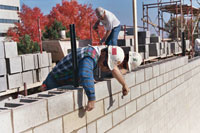Design-build is gaining popularity for North American construction projects. This article introduces design-build and its benefits, and touches on its potential role for modern masonry construction.
According to the Design-Build Institute of America (DBIA), the basic idea of design-build, and its biggest claimed advantage, is having one entity with full responsibility for taking a project from concept to completion. Responsibility translates to accountability and brings with it the power to control the whole job, including all the important aspects like cost, schedule, and quality. The single-entity approach provides the potential to reduce administrative burdens of the owner.
There are three usual approaches to administrative organization of D/B:
- Integrated design-build firm, where architects, engineers, and builders all work for the same company.
- A prime contractor with a subcontractor, where both a design firm (A/E for architect-engineer) and a building contractor are involved, but either entity can be the lead.
- A joint venture between an A/E and a contractor.
DBIA indicates that design-build has been growing steadily for the past 30 years. Since the mid-1990s, it has come on strong, particularly for complex and unusual projects. That said, there is no reason it can’t be used on any type of job. In fact, DBIA estimates that over 50 percent of non-residential design and construction will be via design-build by the year 2015.
The advantages of design-build apply to most, if not all, types of construction. But masonry construction, in particular, provides a good fit with design-build. Outlined below are several reasons why the two are suited to each other.
 A masonry wall can have various craftspeople working on it at any given time.
A masonry wall can have various craftspeople working on it at any given time.
Coordination
Design-build optimizes the teamwork approach. In masonry, there are a number of different specialists working on any given job. For structural masonry, masons lay units and mortar but others may place reinforcement. Where another type of structural backup is used, coordinating masonry infill or veneer work with the other trades can require extensive scheduling. Timing these activities may be better accomplished when there are complementary, rather than competing, forces at work. Design-build is well suited to this coordination, because there is a clear hierarchy and a single person or group with the right knowledge of (critical) activities.
No Lead Time
There is a perception that masonry construction takes longer than other materials because it is laid by hand, one piece at a time. However, most masonry walls are made from materials that are in stock and ready for immediate delivery. Design-build, primarily because it allows for the sharing of knowledge, uses this timing to the advantage of the schedule. No long lead times (for off-site activities) equals early starts and faster project completion.
Moderate Building Size
Especially for buildings of a certain size, design-build offers the potential to optimize the masonry construction process to arrive at a time-competitive schedule. Smaller to medium size buildings—single-story “big-box” buildings and structures up to four or five stories tall—are quickly erected with masonry. And the marriage of material with application is a good one. Many of the best attributes of masonry, like fire resistance, thermal mass, and acoustic privacy, are captured for these types of buildings, such as hotels, theaters, commercial retailers, and multi-family housing (apartments, residence halls).
Resources